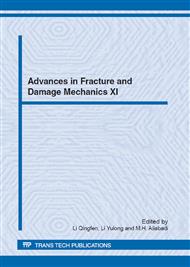[1]
Griza S., et al. – Fatigue failure analysis of a specific total hip prosthesis stem design, International Journal of Fatigue, Vol. 30, 2008, pp.1325-1332.
DOI: 10.1016/j.ijfatigue.2007.11.005
Google Scholar
[2]
Kurtz S., et al. – Projections of primary and revision hip and knee arthoplasty in the United States from 2005 to 2030, Journal of Bone Joint Surgery, Vol. 89, 2007, pp.780-785.
DOI: 10.2106/jbjs.f.00222
Google Scholar
[3]
Mattei L., et al. – Lubrication and wear modeling of artificial hip joints: A review, Tribol Int. (2010), doi: 10. 2016/jtriboint. 2010. 06. 010.
Google Scholar
[4]
Hip and Knee Survey (2009).
Google Scholar
[5]
Senalp A.Z., et al. – Static, dynamic and fatigue behavior of newly designed stem shapes for hip prosthesis using finite element analysis, Materials and Design, Vol. 28, 2007, pp.1577-1583.
DOI: 10.1016/j.matdes.2006.02.015
Google Scholar
[6]
Joshi M.G., et al. – Analysis of a femoral hip prosthesis designed to reduce stress shielding, Journal of Biomechanics, Vol. 33, 2000, pp.1655-1662.
DOI: 10.1016/s0021-9290(00)00110-x
Google Scholar
[7]
Gravius S., et al. – In vitro interface and cement mantle analysis of different femur stem designs, Journal of Biomechanics, Vol. 41, 2008, p.2021-(2028).
DOI: 10.1016/j.jbiomech.2008.03.041
Google Scholar
[8]
Nordin M., et al. – Biomechanics of the hip, Basic Biomechanics of the Musculoskeletal System, third ed. Lippicott Williams & Wilkins, Baltimore, MD, 2001; pp.202-221.
Google Scholar
[9]
Peng T.P., et al. – Review of osteoporosis, J. Jiangxi Univ., Tradit. Chinese med., Vol. 8.
Google Scholar
[10]
Prendergast P.J. – Finite element models in tissue mechanics and orthopedic implant design, Clinical Biomechanics, Vol. 12, 1997, pp.343-366.
DOI: 10.1016/s0268-0033(97)00018-1
Google Scholar
[11]
Fialho J.C., et al. – Computational hip joint simulator for wears and heat generation, Journal of Biomechanics, Vol. 40, 2007, p.2358 – 2366.
DOI: 10.1016/j.jbiomech.2006.12.005
Google Scholar
[12]
Qian J. G., et al. – Examination of femoral-neck structure using finite element model and bone mass density using dual-energy X-ray absorption, Clinical Biomechanics, Vol. 24, 2009, pp.47-52.
DOI: 10.1016/j.clinbiomech.2008.09.007
Google Scholar
[13]
http: /www. ortho. in.
Google Scholar


